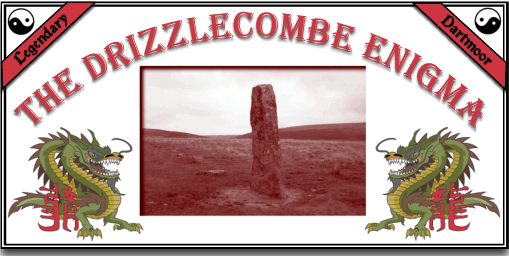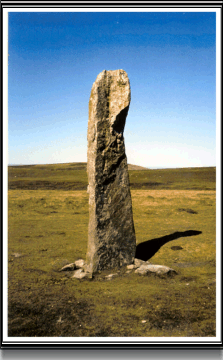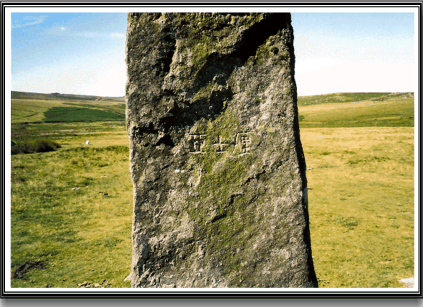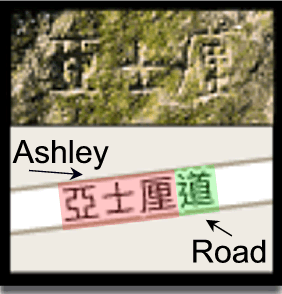
Down in the Drizzlecombe Valley are the remnants of a prehistoric ritual centre comprising of standing stones, a stone, row, barrows and kistvaens. For thousands of years these ancient granite stones have held the secrets of the old men of the moor. Throughout the millennia they have silently stood in that small windswept valley witness to the ever changing moorland moods. Some say they stand guard over the tombs of their long dead builders as if mounting an eternal vigil. The actual name of the valley, Drizzlecombe, is said to derive from the old moorland name of Drishel – a thrush and cum – a valley which meant ‘valley of the thrush’. Nearby is the now huge despoilt cairn known as ‘The Giant’s Basin and about 1 mile away is Deadman’s Bottom, the supposed site of a prehistoric crematorium. All very evocative names for such a sacred landscape.
The largest standing stone was shaped and erected in a very mysterious way, it as if it can ‘shape shift’ at will. When viewed face on it appears to be a huge, flat granite slab but side-on the flatness transforms into something resembling a sword hilt and pommel. Clearly the shape of this monolith was no accident and had some deep rooted meaning in the minds of its Bronze Age architects.
Generations of moorfolk have wondered at its purpose and many later antiquarians have tried to suggest reasons for its form. Some said that the ancient Druids erected it in order to perform their secret rites and ceremonies.

The Drizzlecombe Longstone
Recently the large menhir revealed another secret in the form of some enigmatic symbols. None of the early Dartmoor writers give mention of the strange writings and so it could be suggested that they have only just come to light. Even Jeremy Butler writing in 1994 makes no reference to the strange ‘graffiti’. Today they are certainly visible and can hardly evade a sharp eye, so had they been buried under layers of lichen or the grime of centuries? More to the point, were they some mystic scribings in a unknown prehistoric form of hieroglyph? What did they signify? Who put them there? The questions were endless and the answers very noticeable in not coming forward.

The Enigmatic Symbols of the Drizzlecombe Longstone
Somehow the answer evaded the greatest academic minds that the archaeological world could supply. Were they perhaps some ancient spell or curse carved into the granite guardians as a deterrent to would be grave robbers? Just maybe they were not symbols but were the mark of the ancient mason who created the menhir. Perhaps the old antiquarian writers were correct and the Druids did use the stones. What if this and what if that – IF my granny had testicles she would have be my grandfather!
Urban legend has it that in the late 1990’s a party of Japanese school children were visiting the standing stones with their teacher. It did not long for them to spot the symbols much to the embarrassment of the teacher. He then informed the appropriate authority that there was some obscene graffiti written in Japanese on their standing stones. This soon cleared up the Drizzlecombe Enigma and very little has been heard about the matter since except it is not common knowledge as to exactly how obscene the writing is and what it actually says. If anybody reading this page can tell me I will be most grateful.
One recent suggestion has been made that after showing the symbols to a young Japanese student he translated the symbols as depicting the word ‘ASIA’ which would tie in with the story that they are of an oriental origin although not of an obscene nature.
How wonderful is the power of the internet? I have just recieved the following email:
Hello, My girlfriend Miho and I have just returned from a trip to Dartmoor which we enjoyed very much. We were reading about the ancient monuments on your excellent website legendary Dartmoor when we found the reference to the Drizzlecombe enigma. I was intrigued by the Japanese connection so I asked Miho (who is Japanese) about the meaning of the characters on the stone. She says that the combination of characters has no meaning in Japanese (obscene or otherwise), also the third character is no longer in current use so she guessed that they were probably a name. A Google search using the Kanji (Chinese characters) showed that they are actually the Chinese name used for Ashley Road, Kowloon in Hong Kong. 亜(亞) 士厘道 If your email program can display Chinese characters you will see 5 Kanji characters. The last character道 simply means road and is not on the Drizzlecombe stone. The character in brackets 亞 is an alternative form of the first character and it is this second form which is used on the websites referring to Ashley road. So what is inscribed on the stone is亜士厘 meaning “Ashley”. You can check this out by going to the Google maps web page and searching for ” Ashley road Hong Kong” . If you zoom in, the display will show the English and Chinese versions of the name. So the origin would seem to be in Hong Kong, although this does not explain who would put it there (someone called Ashley trying to create an enigma?).
About the urban legend of the obscene message this may have originated in a simple misunderstanding. For Japanese people writing graffiti like this is considered very rude behaviour so it is possible that at some stage a Japanese person has indeed reported something “rude” being written on the stone.
Douglas and Miho
And sure enough, as Douglas says – ‘Ashley’

 Legendary Dartmoor The many aspects past and present of Dartmoor
Legendary Dartmoor The many aspects past and present of Dartmoor
